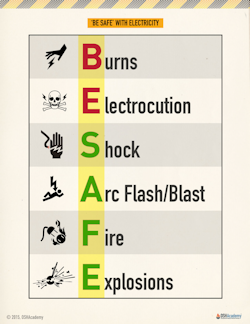Definitions
An electrical hazard can be defined as a serious workplace hazard that exposes workers to burns, electrocution, shock, arc flash/blast, fire, or explosion.
BE SAFE by recognizing, avoiding, and protecting against all of these electrical hazards. See what the BE SAFE terms mean below.
B = Burns
A burn is the most common shock-related injury. Burns from electricity are caused by electrical, arc flash, or thermal contact.
E = Electrocution
Electrocution is fatal; it means to kill with electricity. Electrocution results when a human is exposed to a lethal amount of electrical energy.
S = Shock
Shock results when the body becomes part of the electrical circuit; current enters the body at one point and leaves at another. Electrical shock is defined as a reflex response to the passage of electrical current through the body.
A = Arc Flash/Blast
An arc flash is the sudden release of electrical energy through the air when a high-voltage gap exists, and there is a breakdown between conductors. An arc flash gives off thermal radiation (heat) and bright, intense light that can cause burns. Temperatures have been recorded as high as 35,000° F. High-voltage arcs can also produce considerable pressure waves by rapidly heating the air and creating a blast.
An arc flash can be spontaneous or result from inadvertently bridging electrical contacts with a conducting object. Other causes may include dropped tools or the buildup of conductive dust or corrosion. For more information on arc flash/blast, including best practices in electrical safety, refer to NFPA 70E: Standard for Electrical Safety in the Workplace®
F = Fire
Most electrical distribution fires result from problems with "fixed wiring" such as faulty electrical outlets and old wiring. Problems with cords (such as extension and appliance cords), plugs, receptacles, and switches also cause electrical fires.
E = Explosions
An explosion can occur when electricity ignites an explosive mixture of material in the air.
Knowledge Check Choose the best answer for the question.
1-2. A sudden release of electrical energy through the air when a high-voltage gap exists due to a breakdown between conductors is called _____.
You forgot to answer the question!

